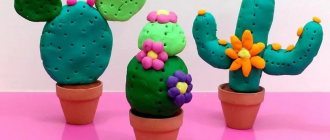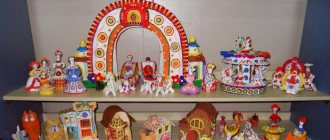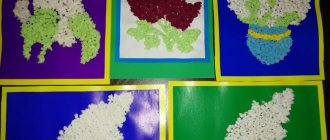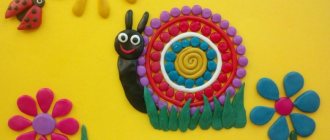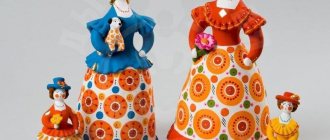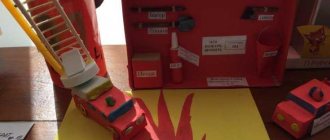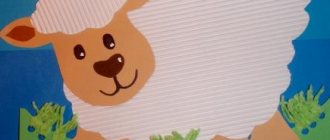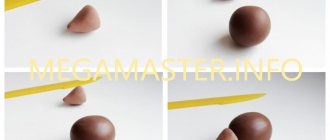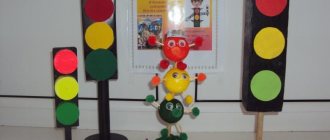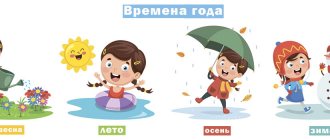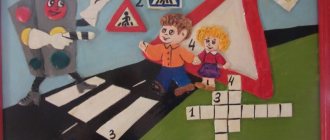Materials
What you will need for sculpting:
- brown block of plasticine - main;
- orange (or beige), black and white - additional micro pieces;
- toothpick.
Step-by-step instruction
How to make a bear from plasticine step by step
- The bars that are present in plasticine sets are small. But even this portion will be quite enough to sculpt a small plasticine copy of the animal. The child will have to work with very small soft parts, which is useful for developing fine motor skills of the fingers. If the size of the available brown plasticine does not suit you, you can always mix it with some other color to make it larger. For example, adding black will result in a dark brown piece, white or yellow will result in a light brown piece, and so on. Such experiments with shades are also very useful. So, prepare the main block.
Preparing the main block of plasticine
- Mash it thoroughly and divide into portions. During the work you need to show the body, paws, head and ears of the bear. Start from this.
Knead the plasticine and divide into portions
- For the head, model a ball. For the ears, make 2 small balls of the same size and flatten them with your fingers into round cakes.

We sculpt a head for a bear from plasticine
- Next, move on to the remaining pieces while they are still soft. Make the body oval and the legs into oblong tubes. Bend the lower tubes additionally at the ends so that the bear can later stand.
We sculpt the body and legs
- Make small cuts at the ends of the legs with the tip of a toothpick. Glue the legs to the body. Secure a toothpick at the top - a simple axis that will allow you to secure the head in the future.
Notches on the paws, glue the paws to the body, and attach a toothpick
- Attach the head with ears to a toothpick.
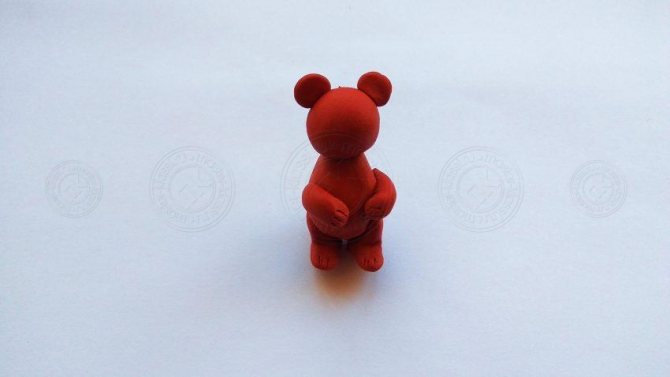
An example of how to attach a head with ears to a plasticine bear
- Glue cheeks, eyes, eyebrows, nose onto the face. Use the tip of a toothpick to show the fur on your cheeks.
Finalizing the bear's head
- A small plasticine craft - a plasticine bear - is ready.
Photo of the finished plasticine bear
+1
Summary of the “Bear” sculpting lesson for the senior group
Lyudmila Yudina
Summary of the “Bear” sculpting lesson for the senior group
Summary of a lesson in artistic creativity (modeling) for the senior group “Bear”.
Educational field – artistic
Target:
Form aesthetic tastes, develop creativity and thinking.
Tasks:
Learn to sculpt an object consisting of several parts, conveying characteristic features (ears, muzzle). Reinforce familiar sculpting techniques: rolling, unrolling, connecting parts using the technique of smearing. Develop independence, cultivate interest in modeling.
Integration of educational areas: cognition, physical education, reading fiction, artistic creativity.
Material:
plasticine; boards for modeling; images of a bear; toy bear".
Preliminary work:
Reading fiction “Teremok”, “Three Bears”; “Mashenka and the Bear”, a conversation about the wintering of the bear, its food products, its living conditions, looking at illustrations depicting a bear, solving riddles, watching the presentation “Wild Animals”.
Progress of the lesson:
Educator:
Guys, a guest will come to us today, but before he appears, we must guess who it is. I'll tell you a riddle, and you tell me the correct answer.
Clubfoot and big,
He sleeps in a den in winter.
Loves pine cones, loves honey,
Well, who will name it?
Children: Bear.
Educator:
Right! Listen, a short excerpt that talks about the bear “Who among us does not know a bear? Big, clumsy, club-footed. This is exactly the opinion we hold about this beast. But in reality the bear is not like that. He is very agile and dexterous. The bear is a formidable forest dweller who will not let anyone down if he is not in the mood. Belongs to the bear family. The bear is a predatory mammal that swims well and climbs trees. One blow and the bear can kill another animal. The bear's legs are thick, its head is massive with small ears and eyes, and the color of its fur is changeable. Although the bear is a typical predator, he also likes to enjoy plant desserts: berries, fruits, grains, grass, plant roots,” but don’t be afraid, our guest is very kind, he came to us from a fairyland.
(there is a knock on the door. The teacher brings in a toy). Guys, we forgot to say hello to our guests, how can we greet beautifully?
Children:
Hello, we are very glad to see you!
Educator: Bear told me that he is bored alone in the den in winter, how can we help him?
Children: Let's make little bear cubs.
Educator: But first we’ll play a game with you. The game is called “Teddy Bear”, you need to perform movements in accordance with the text. So, let's go to our clearing and stand in a circle.
A clubfooted bear is walking through the forest,
He collects the cones and puts them in his pocket,
Suddenly a cone fell, right on the bear’s forehead,
The bear got angry and stomped his foot.
“I won’t collect pine cones anymore,
I’ll get in the car and go to bed!”
Educator: It’s still too early for Mishka to go to bed, we’d better go to the table and see how our guys will sculpt the bear cubs.
Children: go to the tables and sit down in their places.
Educator: Guys, what parts does the bear consist of?
Children: torso, head, paws and tail.
Educator: How are we going to sculpt the body, what does it look like?
Children: oval body.
Educator: And the head?
Children: Round.
Educator: Please note that the bear has an elongated muzzle and has ears on its head! How many ears does a bear have? Let's count?
Children: 1 – 2. 2 ears
Educator: Yesterday I made a bear, would you like me to show it to you?
Children: Yes.
Educator: I stretched out the muzzle with my fingers, and made the ears by pinching plasticine. Which part of the body do you think we'll start working on? Explain why you think so?
Children: From the body, because we will attach all parts of the body to it.
Educator: What are we going to sculpt after the body is done?
Children: Let's sculpt the head.
Educator: We will have a torso and a head, do we need them?
Children: Connect.
Educator: In order for our head to hold firmly, we must use the technique of smearing. What remains for us to make so that the bear is ready?
Children: Paws and tail.
Educator: How many paws does a bear have, let's count.
Children: 1, 2, 3, 4 -4 paws.
Educator: We will make them from balls, but we will need 5 balls, what is the fifth one for?
Children: For the ponytail.
Educator: Guys, when you start working, I will play some music for you, it will help you unleash your creative abilities. There is plasticine on our tables, we need to divide it into 3 parts, one part should be a little larger, the other two parts should be the same. From the larger part we mold the body, from the other part - the head, and we need to divide the last part into 5 more equal parts, these will be the paws and tail. Let's get to work. (music is turned on, preferably sounds of nature)
During work, the teacher gives children advice and, if necessary, provides assistance.
Analysis:
Look, guys, what cute little bear cubs you have made.
(Ask the children whose work they liked and why, tactfully draw attention to the shortcomings in some works, offer to try to avoid them next time).
Guys, let's invite our guest to choose new friends. (The little bear happily selects all the children’s works and thanks the children for the gifts). The children invite him to come visit again.
The little bear treats the children to cookies and says goodbye.

